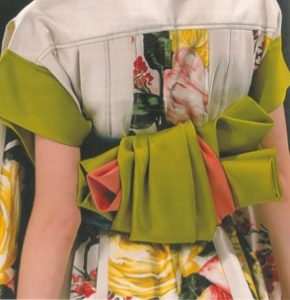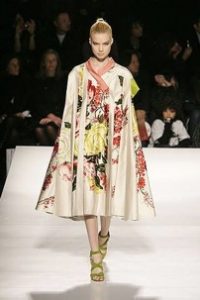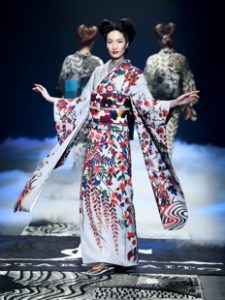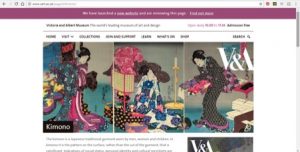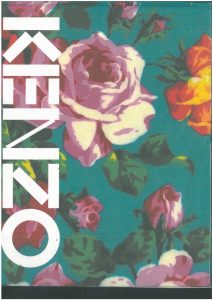Images of Kenzo’s 2008 Autumn/Winter collection (page 122 in book). There is clear influence of traditional Japanese Kimono with the back of the garment modernising the Obi belt of the traditional garment.
Image on left is from the Kenzo book published by Rizzoli New York, photographer unknown
Image on right is from http://www.elle.com/runway/fall-2008-rtw/g17649/kenzo-225307/?slide=45 (The book didn’t have a front picture of the garment so I wanted to find it to support the evidence of Kimono influence)
Tokyo fashion week March 2016 Jotaro Saito Photographer unknown
Image shows how kimono has been redesigned and adapted into high fashion concepts. “I represent the third generation of kimono makers in my family, and we have always worked more like designers than shokunin craftspeople.”
Then I began looking for an archive which would broaden my understanding of Kimono and its history. I found that the V&A has a large collection of Kimono in its archive and a lot of information on the topic with separate articles on the topic as well which is very helpful at broadening my understanding of the Kimono and the culture behind it. The collections on the website are also effective at providing reliable information. http://www.vam.ac.uk/page/k/kimono/
From conducting my own research in the library I found Kenzo’s book by Rizzoli New York which contained a vast amount of his collections over the years, with his 2008 Autumn/Winter collection standing out the most to me. I applied my own contextual knowledge when observing his work to find that he took inspiration from traditional female Kimono in the way he had adapted the obi belt into his piece by having the fabric form a back detail in his garment as this is similar to how obi is tied. After I researched into what the front of the garment looked like I also found it to have a play on the neckline of kimono as well.
I extended my research from these initial images in the library by exploring how other high fashion designers have taken inspiration from Kimono in their designs but made it modern and put their own personal style on it. This was done by doing an image search of Kimono on google which led me to find Jotaro Saito’s work in his Spring/Summer 2016 collection which was heavily inspired by traditional Kimono but designed with a modern outlook in its designs and pattern cutting. This image took me to an article about the designer in the Japanese Times where it was explained that he is a third generation kimono maker in his family who have always made kimono but with a “designer” state of mind rather than a more traditional one which interested me greatly as it shows how tradition has been rethought within his family to create something visually stunning and captivating.
With Jotaro having ties to traditional Kimono construction and design through his family heritage I decided that it would be beneficial to research into an archive which had more information on the traditional dress in its raw form. This lead to me finding the V&A’s Kimono archive which is extremely vast and in-depth with many pieces being displayed within it ranging from more common clothing to more lavish pieces which was very beneficial to my research as it demonstrated the range of different cuts and designs within Kimono itself and how culture and society effected these qualities. The V&A have a specific home page for their Kimono archive which branches off into different articles and pieces relating to the subject addressing different topics surrounding it. These articles are packed with reliable information about Kimono and inform me of things about the traditional dress style which I didn’t know previously.
This contextual research journey has been beneficial to my approach to research as I can see how a small piece of information such as my library image can expand into new topics and information which I didn’t know previously and can help inform my designs to make them more personal and knowledgeable. By beginning with Kenzo’s work I have also been able to understand how incorporating your own cultural history and personal experiences into your design work can make help develop a personal style and visually be stimulating for the audience.
Bibliography
http://www.elle.com/runway/fall-2008-rtw/g17649/kenzo-225307/?slide=45
http://www.vam.ac.uk/page/k/kimono/
“Kenzo” By Rizzoli New York Published 2010 Image chosen is from 2008 Autumn/Winter collection (page 122 in book).
Designer Jotaro Saito seeks to free the kimono from the confines of tradition

